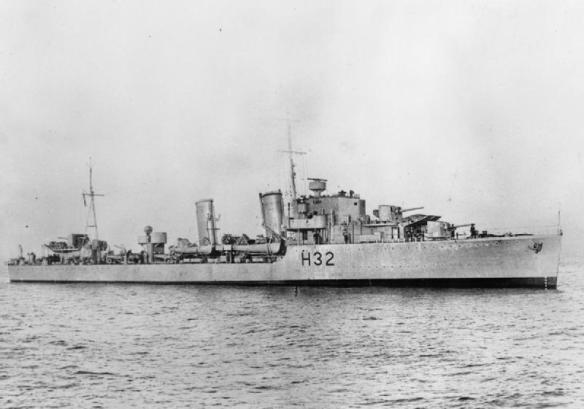British destroyer HMS Havant (H32) stopped. 3 May 1940
HMS ‘Havant’ off Dunkirk, May 1940
The third and final Royal Navy destroyer loss at Dunkirk of 1 June was Havant, Lieutenant-Commander Anthony Burnell-Nugent. Beginning on 29 May, Havant made four runs across the Channel. On her first she left Dover at 1815. By 0900 she was off Braye beach. She returned to Dover at 0400 next morning and put ashore five hundred French troops. She put to sea in the early hours of the 3rd with orders to embark troops from a beach to the east of Dunkirk. By 1700 that evening she arrived at Dover with a thousand troops. She then sailed for Dunkirk and by 2145 was alongside taking on more troops. It took only 30 minutes to hurry on board a thousand soldiers. At 0230, 1 June, they were going ashore at Dover. Havant then cleared harbour for a return to Dunkirk, arriving at 0730 at the same berth as before.
At 0800 an intense aerial bombardment began at Dunkirk. Troops were arriving at the jetty at such a slow rate that it took half an hour to embark fifty. During this phase the Ivanhoe, just outside the harbour and loaded with troops, was hit amidships. Havant cast off and went to her aid. She put alongside Ivanhoe at 0840 and began transferring troops and wounded. As Philip Hadow, Ivanhoe’s captain, hoped to get underway very shortly, he refused a tow. Havant at full speed set off for Dover.
While proceeding down channel and parallel to the beach west of Dunkirk, Havant came under shore gunfire, high and low-level bombing, and intense dive-bombing. Havant was zigzagging as much as the width of the channel would permit when at 0906 she was hit in the engine room by two bombs which tore two holes (one with a diameter of 6 feet and the other of 3 feet) on the starboard side of the engine room just above the water-line. Almost immediately afterwards a large bomb dropped about 50 yards ahead. This bomb had a delay action and exploded directly beneath Havant as she passed over it, momentarily giving the impression of lifting the whole ship. By this time the engineer officer and all the ERAs had been either killed or wounded. The after ready-use ammunition lockers had blown up, causing many casualties among the soldiers on the upper deck.
Out of control Havant steamed ahead. She had taken on a gradual turn to starboard and this sent her towards sand-banks opposite Dunkirk. It was impossible to enter the engine room to stop this ship. As the cut-off valve on the upper deck was bent and broken the only method of stopping was to let the steam out of the boilers. The chief stoker was able to do this, despite there being a fire in one of the boiler rooms. Havant was eventually brought up in four fathoms by the starboard anchor. Signals for assistance were made to the minesweeper Saltash and a large yacht. Both vessels came alongside, one on each quarter, and the transfer of troops was undertaken. Bombing throughout the proceedings was almost continuous. A tow was passed between Saltash and Havant. Towing was taken up at slow speed.
Havant’s list to port increased sufficiently for her captain to call alongside another vessel, the Aegair, so as to transfer the crew, with the exception of his officers and twenty ratings. About this time Havant was attacked by heavy bombers. A group of bombs entered the sea very close to Havant’s port quarter, causing further damage. With the port side of the upper deck almost awash, the seaworthiness of Havant was getting worst by the minute. Following a brief conference with some of his officers, Burnell-Nugent decided to abandon ship. The tow was slipped and Aegair went alongside. Those of the ship’s company remaining were transferred. As at this time Havant was in an area of deep water, her magazines were flooded to ensure her sinking before she could drift on to a sandbank. Saltash fired several rounds into Havant to hasten the end. At 1015 Havant sank from view. Under the circumstances casualties were light: one officer and seven ratings killed and about twenty-five men wounded. At least twenty-five soldiers were killed or wounded. Operation Dynamo was not the only evacuation of Allied troops from France in June 1940. Operations Cycle and Aerial were evacuations, the latter mainly from the Biscay ports. The Royal Canadian Navy destroyer Fraser, Commander Wallace Creery, RCN, was part of Aerial when she was involved in a collision with the British cruiser Calcutta.
* * *
The great strain during the hectic days of evacuation, together with fatigue from lack of sleep, certainly had an effect on ships officers, particularly those in command. Under such circumstances judgement was always liable to be impaired and an error of judgment may well have contributed to Fraser’s loss, which occurred on the last day of Aerial, 25 June.
